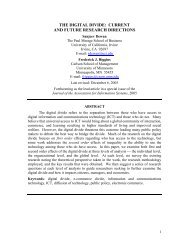When Should Software Firms Commercialize New Products ... - MISRC
When Should Software Firms Commercialize New Products ... - MISRC
When Should Software Firms Commercialize New Products ... - MISRC
You also want an ePaper? Increase the reach of your titles
YUMPU automatically turns print PDFs into web optimized ePapers that Google loves.
and αb +δb ≥ 0.75. Then π ∗ CE ≤ 0.25c, π∗ TLF = 0.25c, and π∗ FLF<br />
≥ 0.3c. By switching to<br />
FLF, the firm can achieve at least 20% profit increase. Thus, it is important for the firm<br />
not just to consider implementing any freemium model, but to carefully choose between the<br />
available freemium options.<br />
8 Social Welfare Analysis<br />
It is straightforward to show that, under a central planner economy, the optimal price<br />
under each of the five models is zero due to sunk costs. In this section we focus on the more<br />
interestingsocial welfareimplications whenthefirmchoosesitsoptimal pricingstrategy. We<br />
denote by SW ∗ M<br />
the social welfare corresponding to the profit maximizing strategy under<br />
model M, where M ∈ {CE,FLF,TLF,SS,CS}. Define function φ : [0,13 −4 √ 10] → R,<br />
1+2x+2x φ(x) = 1− 2<br />
2(1+x)( √ 1+x+ √ 2x) 2. We show in the Appendix in Lemma A6 that φ is strictly<br />
increasing over the interval [0,13−4 √ 10], with φ(0) = 1<br />
2 and φ(13−4√10) ≈ 0.82 < 7<br />
8 < 1.<br />
Then, we have the following social welfare ranking:<br />
Theorem 2. The following hold true:<br />
(a) SW∗ TLF > max{SW∗ CE ,SW∗ SS ,SW∗ CS } for any α > 0;<br />
(b) SW ∗ FLF ≥ SW∗ TLF<br />
(i) γ ≤ 1<br />
3 ; or<br />
(ii) 1<br />
3 < γ ≤ 1 and φ−1<br />
(iii) 1 < γ <<br />
if and only if one of the following conditions is satisfied:<br />
<br />
7γ−1<br />
8γ<br />
≤ αb +δb; or<br />
1<br />
7−8φ(13−4 √ ≈ 2.262 and φ−1<br />
10)<br />
7γ−1<br />
8γ<br />
<br />
≤ αb +δb < 13−4 √ 10.<br />
The results in Theorem 2 are illustrated in Figure 3. Note that, when the firm max-<br />
imizes profit, social welfare under CE, SS, and CS models is always smaller than under<br />
TLF model. Thus, highest social welfare will be attained under either FLF or TLF. In<br />
other words, freemium, in one form or another, is always preferred from the society’s per-<br />
spective. The adoption dynamics for FLF can be explained through Figure 1 with αb +δb<br />
instead of α on the horizontal axis. <strong>When</strong> αb + δb ≥ 13 − 4 √ 10, then, under FLF, we<br />
have only period 1 adoption and exactly half of the potential customers purchase module<br />
B. Therefore, under both FLF and TLF, high-type customers (with type θ ≥ 1<br />
2 ) get to<br />
use both modules A and B for two periods. The difference is that, under FLF, low-type<br />
24
















